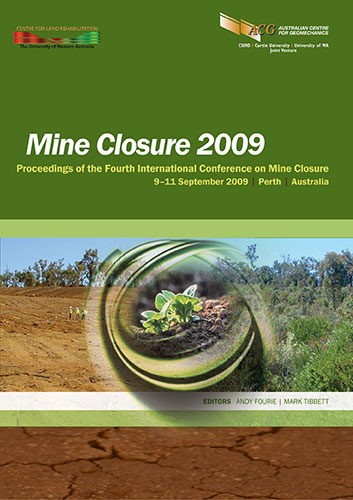Effect of mineralogical and geochemical properties on reflectance properties of waste from Sokolov open pit lignite mine, Czech Republic

|
Authors: Kopačková, V; Bourguignon, A; Chevrel, S; Koubová, M; Rojik, P Paper is not available for download Contact Us |
DOI https://doi.org/10.36487/ACG_repo/908_45
Cite As:
Kopačková, V, Bourguignon, A, Chevrel, S, Koubová, M & Rojik, P 2009, 'Effect of mineralogical and geochemical properties on reflectance properties of waste from Sokolov open pit lignite mine, Czech Republic', in AB Fourie & M Tibbett (eds), Mine Closure 2009: Proceedings of the Fourth International Conference on Mine Closure, Australian Centre for Geomechanics, Perth, pp. 569-580, https://doi.org/10.36487/ACG_repo/908_45
Abstract:
The reported study aimed to identify low-pH areas at the Sokolov lignite open pit, using space borne and ground-based spectroradiometry. Mineral spectroradiometry, from spaceborne sensors and ground measurements, represents an alternative to conventional methods and provides an efficient way to characterise mines and assess the potential for acid mine drainage (AMD) discharge. The mineralogical composition of sediments is primarily a determinant of their inherent reflectance properties. However, additional parameters such as organic matter content and trace element abundance are also known to have an influence on soil and sediment reflectance. As long as the effects of sediment composition, organic matter content and trace element abundance can be spectrally distinguished, it might be possible to map these variables at synoptic scales using remotely sensed data. In mining environments (still active and abandoned mines), mapping the spatial distribution of mineral composition and the additional soil/rock parameters provide unique constraints on both the origin of the allochthonous material as well as the geochemical processes that occur at the site. Field and laboratory spectra of more than 250 surface rock samples at the Sokolov open pit mine, Czech Republic, were measured using an analytical spectral device (ASD) spectroradiometer during field investigations in 2007 and 2008. Additional in situ and laboratory pH measurements, X-ray powder diffraction (XRD) analyses and other laboratory methods allowing a quantitative diagnostic of trace elements, sulphur and organic matter were conducted on the selected field samples. Firstly, the effect of the mineralogy and the geochemical variables, e.g. organic matter and AMD mineral indicators, on the rock reflectance property was studied and then the feasibility of resolving some of these effects with satellite imagery, e.g. advanced spaceborne thermal emission and reflection radiometer (ASTER) was tested.
References:
Beckett, P.H.T., Davis, R.D., Brindley, P. and Chem, C. (1979) The disposal of sewage sludge onto farmland: the scope
of the problem of toxic elements, Water Pollution Control, Vol. 78, 419 p.
Ben-Dor, E., Inbar, Y. and Chen, Y. (1997) The Reflectance Spectra of Organic Matter in the Visible Near-Infrared and
Short Wave Infrared Region (400–2500 nm) during a Controlled Decomposition Process, Remote Sensing of
Environment, Vol. 61, pp. 1–15.
Bowen, H.J.M. (1979) Environmental Chemistry of the Elements, Academic Press, New York, 333 p.
Chevrel, S., Kopačková, V., Bourguignon, A., Rojík, P. and Metelka, V. (2008) Monitoring Hazardous Wastes Using
Space-borne and Ground-based Spectroradiometry – Sokolov Lignite Mines: Czech Republic, In Proceedings of
the Third International Seminar on Mine Closure, Mine Closure 2008, A.B. Fourie, M. Tibbett, I.M. Weiersbye,
P. Dye (eds), 14–17 October 2008, Johannesburg, South Africa, Australian Centre for Geomechanics, Perth,
pp. 651–662.
Clark, R.N., King, T.V., Klewja, M. and Swayze, G.A. (1990) High spectral resolution reflectance spectroscopy of
minerals, Journal of Geophysical Research, Vol. 95, pp. 12653–12680.
Gomes, M.E.P. and Kavas, P.J.C. (2006) Mineralogical controls on mine drainage of the abandoned Ervedosa tin mine
in north-eastern Portugal, Applied Geochemistry, Vol. 21, pp. 1322–1334.
Hammarstrom, J.M., Seal II, R.R., Meier, A.L. and Jackson, J.C. (2003) Weathering of sulfidic shale and copper mine
waste: secondary minerals and metal cycling in Great Smoky Mountains National Park, Tennessee and North
Carolina, USA, Environmental Geology, Vol. 45, pp. 35–57.
Hunt, G.R., Salisbury, J.W. and Lenhoff, C.J. (1972) Visible and near-infrared spectral of minerals and rocks:
V. Halides, phosphates, arsenates, vanadates, and borates, Modern Geology, Vol. 3, pp. 121–132.
Jambor, J.L., Nordstrom, D.K. and Alpers, C.N. (2000) Metal-sulfate salts from sulfide mineral oxidation, In Sulfate
Minerals—Crystallography, Geochemistry and Environmental Significance, C.N. Alpers, J.L. Jambor, D.K.
Nordstrom (eds), Reviews in Mineralogy and Geochemistry, Vol. 40, pp. 305–350.
Kabata-Pendias, A. and Pendias, H. (2000) Trace elements in soils and plants, Third edition, CRC Press LLC, Boca
Raton, Florida.
Rojík, P., Galek, R. and Píásav, J. (1998) Sokolov lignite basin, In Excursion Guide, Eighth Coal Geology Conference,
Faculty of sciences, Charles University, Prague, pp. 1–69.
Rojík, P. (2003) New stratigraphic subdivision of the Tertiary in the Sokolov Basin in Northwestern Bohemia, Journal
of the Czech Geological Society, Vol. 49/3, pp. 173–186.
Settle, J.J. and Drake, N.A. (1993) Linear mixing and the estimation of ground cover proportions, International Journal
of Remote Sensing, Vol. 14, pp. 1159–1177.
Shrbený, O. (1994) Terciér Českého Masívu – Tertiary of the Bohemian Massif, In Geologický atlas České republiky,
J. Klomínský (ed), Stratigrafie.
Swayze, G.A., Smith, K.S., Clark, R.N., Sutley, S.J., Pearson, R.M., Vance, J.S., Hugeman, P.L, Briggs, P.H., Meier,
A.L., Singleton, M.J. and Roth, S. (2000) Using imaging spectroscopy to map acidic mine waste. Environmental
Science and Technology, Vol. 34, pp. 47–54.
© Copyright 2025, Australian Centre for Geomechanics (ACG), The University of Western Australia. All rights reserved.
View copyright/legal information
Please direct any queries or error reports to repository-acg@uwa.edu.au
View copyright/legal information
Please direct any queries or error reports to repository-acg@uwa.edu.au